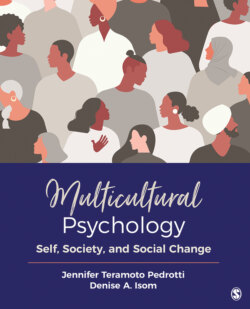Читать книгу Multicultural Psychology - Jennifer T. Pedrotti - Страница 23
На сайте Литреса книга снята с продажи.
Intersectionality
ОглавлениеLast, on this subject, though the different facets are presented as separate groups to some extent, we must also recognize that the phrase “the whole is greater than the sum of its parts” is extremely relevant here. Think of your own identity for a moment. Are you able to separate how your various identities influence how you walk in the world as a whole being? Think for a moment about your gender identity. Is this wholly separate from your racial identity, or does the combination mean something different? Instead of just belonging to one group in one facet, we all have multiple cultural identity facets, and the combinations of these also lead to different life experiences and attitudes. For example, someone who identifies as a lower-socioeconomic, White, gay man may have a very different day-to-day experience from a heterosexual, African American, wealthy woman. Consider the following excerpt from “Theresa,” who is talking about her experience as an Asian American woman in a business environment.
Some of my colleagues expect me to be quieter than the men sometimes, and I was trying to explain this to my male friend who is also Asian. I’m not a very quiet person and so I think sometimes people look surprised when I speak up so quickly. He said, “But I’ve never had that reaction to me when I speak, and I hear Helen speak up fairly often and it doesn’t seem like the men have the same reaction to her when she is louder. So it can’t really be race or gender then, right? Maybe it’s your personal issue?” I had to explain that as an Asian American woman, there are different stereotypes about me being passive or quiet in general, and that this is different from Helen who is African American, though also a woman. They seem to accept that she will be loud, and I think a lot of that is based on stereotypes. And my friend, as a man who is also Asian, gets a different reception as well. They don’t seem to expect him to be as quiet. It’s complicated when it’s all mixed up. I have to act differently to be heard the same way.
—Theresa, age 43
iStock/Rawpixel
In the vignette above, Theresa is trying to explain that it’s a combination of gender and race that dictates at least in part how her colleagues are responding to her. As someone who is Asian and also female, Theresa’s experience is different from the experiences of those who share just her race or just her gender. Identity is complex. Therefore, understanding the different facets and pieces of identity is also a complex process. Knowing someone’s identity statuses in some of the areas Hays discusses may help us to begin to understand some parts of another person who is different from us in some way. This is by no means an exhaustive list or description, but this model helps us to identify and organize understanding of some identity facets and sets the stage for us to begin to talk about intersections between these identities as well.
It is important for us to rely on accurate information, however, in beginning to think about various identities and their intersections. Stereotyping, which has often happened to disenfranchised or historically underrepresented individuals in the past, can create unidimensional understandings of others who are unlike us in some way, and this can too easily lead to labeling and negative judgement about differences.
